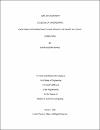EXPLORING CONFIDENTIALITY AND PRIVACY OF IMAGE IN CLOUD COMPUTING
الملخص
With the increasing popularity of cloud computing, clients are storing their data in cloud servers and are using “software as a service” for computing services. However, clients’ data may be sensitive, critical, and private, and processing such data with cloud servers may result in losing data privacy or compromising data confidentiality. Some cloud servers may be dishonest, while malicious entities may compromise others. In order to protect data privacy and confidentiality, clients need to be able to hide their actual data values and send the obfuscated values to cloud servers.
This thesis deals with the outsourcing of computing to cloud servers, in which clients’ images can be computed and stored. This thesis proposes a technique that obfuscates images before sending them to servers, so these servers can perform computations on images without knowing the actual images. The proposed technique is expected to ensure data privacy and confidentiality. Servers will not be able to identify an individual whose images are stored and manipulated by the server. In addition, our approach employs an obfuscating technique to maintain the confidentiality of images, allowing cloud servers to compute obfuscated data accurately without knowing the actual data value, thus supporting privacy and confidentiality.
The proposed approach is based on the Rabin block cipher technique, which has some weaknesses, however. The main drawback is its decryption technique, which results in four values, and only one of these values represents the actual value of plain data. Another issue is that the blocking technique requires a private key for each block that requires a high-computing effort; requiring one private key for each block of data demands that a great number of keys be stored by the client. As a result, it decreases the robustness of the Rabin block cipher.
This thesis proposes additional techniques to overcome some of the weaknesses of the Rabin block cipher by introducing some new features, such as tokenization, a digit counter, and a set of blocks. The new technique increases the privacy of data and decreases the computational complexity by requiring fewer private keys. The new features have been implemented in image processing in order to demonstrate their applicability. However, in order to apply our approach to images, we must first apply some preprocessing techniques on images to make them applicable to being obfuscated by our proposed obfuscating system.
DOI/handle
http://hdl.handle.net/10576/5352المجموعات
- الحوسبة [111 items ]


